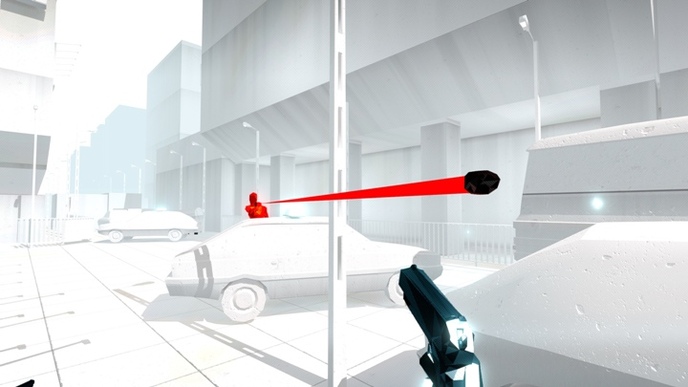Superhot: Halt and Press Fire

Superhot’s time-warped shootouts remind me of a slow-motion fight scene in an action movie, where the arm motions are sped up but the camera slows down and lingers on the impact of every punch. Time moves normally only when you move, and crawls whenever you stand still. It doesn’t stop entirely, which means you can still catch a stray shotgun pellet and die as you weigh your options. But while the idea of slowing down the first-person shooter makes for some interesting combat setups, Superhot’s attempts to be more than a methodical shooter make it stand out less, not more.
The slower combat serves multiple purposes: it allows the average player the kinds of reactions you’d find in high-level Counter-Strike matches, and it punctuates every bullet, punch and thrown object with a sizable heft. Every bullet you drive through a red, crystalline head shatters it, and if you’d like, you can watch the detritus drift for a second or two.
In practice, this makes Superhot a sort of turn-based shooter, albeit with a less diverse toolkit. In the game’s two-hour story mode, you can make use of a pistol, shotgun, assault rifle, the occasional katana, and whatever other black objects happen to be strewn about the room. These guns are perfunctory and aren’t there so you can obsess over their details or similarities to real guns. Besides, the most useful tools you have don’t involve much shooting. You can punch enemies or throw your guns at them to knock their guns away, then grab the guns mid-air and point them back at their owners.
But for all the cool things it lets you do, Superhot is not a carefree game—it revels in the trial and error of a Hotline Miami or N++. When trying these levels over and over again, it’s hard not to think about your own limits as a player. I can’t think fast enough, can’t move with enough grace to really combat multiple opponents at once. so the slow-mo becomes a crutch. Far from a power fantasy, Superhot drives home the desperation of its scenarios. One level pits you in an elevator with three henchmen pointing guns directly at you. After what feels like an hour of dying every two seconds (actually about ten minutes), I weave my way through their shots, take their guns from them, and eventually pop them and the two guards that greet me opposite the elevator doors. After clearing it, I feel more relieved than triumphant.
Once you finish a level, you see a replay of what your path through it would have looked like had you never stopped to think your predicament through. This makes the disconnect between your actions as a player and their results all the more jarring. The person lining up headshots in these replays doesn’t feel like me. It is, but it’s me acting purely on instinct with the skill to back it up. It’s a strange feeling to not recognize yourself in your own actions, but that might be the point the game is trying to make.
To peel back a layer, Superhot isn’t just the shooter I described. The entire game takes place through a fake user interface using ASCII graphics. “Superhot.exe” exists in a DOS-like desktop, amongst ASCII graphics toys and other games. You discover the game through a chat log with a friend, and you get messages about what you’re doing after certain levels. Much of story unfolds through this interface, and as you uncover the nature of what Superhot.exe actually is, you begin diving into a dark, spiraling rabbit hole that consistently questions your role as a player running a computer program.
But the meta layer feels shallow. The moments where Superhot plays with the player are fun at the time, but I never got the sense they were leading to anything. They were just fun things on their own. Superhot pulls at many disparate threads at once, hoping that one of them leads to something impactful. It brings up the topics of game addiction, manipulative game design, and the nefarious uses of modern tech, but that’s all it does: bring them up. It asks questions but never bothers to answer them, or even gesture towards a stance.
